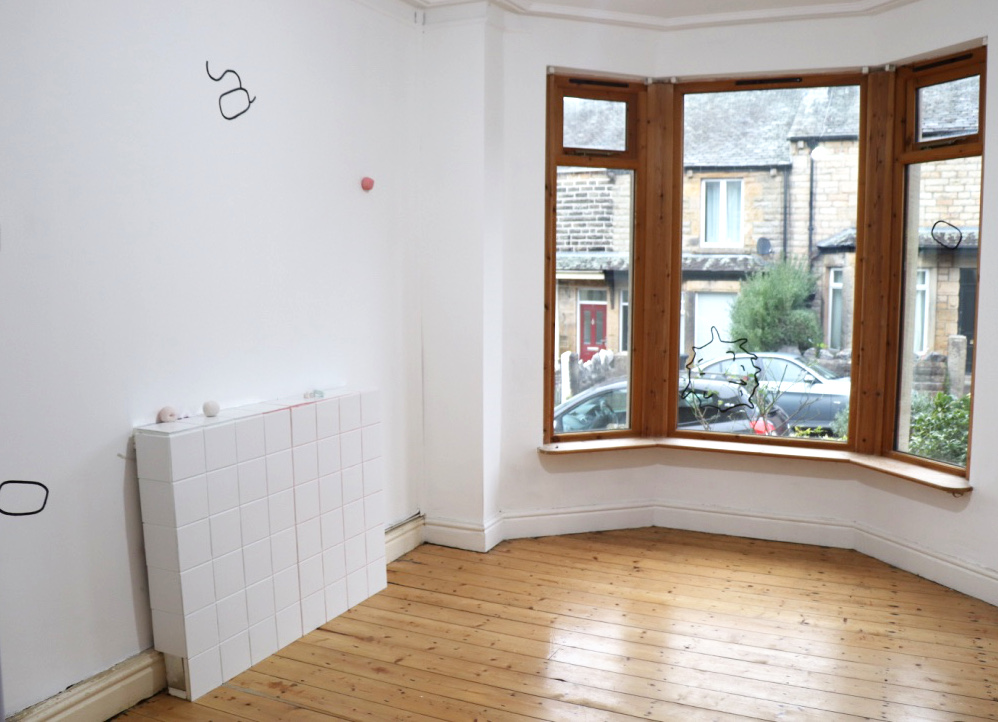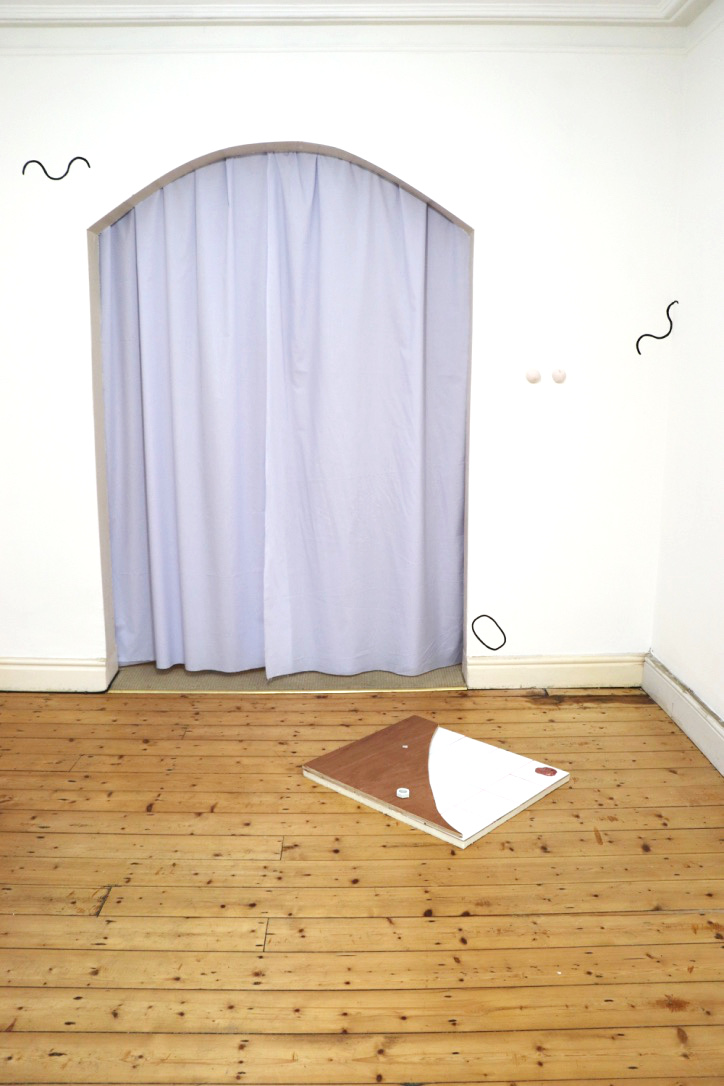Joseph Cotgrave
Interview by Saul Argent
-
Published November 2018
-
This interview was carried out following a residency and presentation by Joseph Cotgrave at GRAFT, Lancaster.
-
Hi Joe, we’ve had you living with us for the past week, and using our living room as a studio/gallery space, making and installing your work on site. It’s been great to watch you working over the past few days, and see the exhibition come together! So, as a first question, can you tell me what you’ve been making?
It’s been good to change what I’m focused on recently. So I’m not necessarily just making work about HIV, but bringing in film references, popular culture as well. That feeling is still there, but I wanted a more activist approach. This came through with films I made with the Terrence Higgins Trust and Thinking Films (for BBC3). Also the workshops I’ve been running. I feel like these things are becoming separate from my practice, and the kind of work I’d been making previously.
The work I’d been making, like on the residency, ‘Migration’ at The Art House, Wakefield, was about materialising my experiences as an HIV positive man facing stigma. The workshops draws from this experience too, but it’s trying the inform the audience about the pills I take and about other prevention methods such as PrEP and PeP. I see them as two separate things, but they meet at certain points.

Can you explain a bit more about how you translate your identity into the work you produce?
I find it quite challenging at times, and I try to avoid being put into a box. It can be a tick-box for some organisations, but that can be important too. It’s important people make work about HIV, I feel like I have a responsibility to do that.

Can you talk a bit more about how education and community are important to your practice, and the limits you feel your work has in achieving that?
I actually don’t like using the word “education” so much, it’s a word of power. I prefer the idea of taking people on a journey through my narrative, and there isn’t a right or wrong way to do this. Education’s not the right word for that, really. I’m still finding the language for it, it’s only really been three years since I started making work about my experience as a gay HIV positive man, so I’m still at an early point in my artistic practice. I do feel that there’s two separate entities – the work I create for exhibitions in white cube like spaces, and then this other side where I’m informing people about HIV and things they might not have access to otherwise. It’s all about access at the end of the day, and galleries aren’t that accessible. I still want to exhibit, but through the workshops it’s easier to help people access information.
Do you think the development of this other side to your work will begin to affect your artistic practice? Will it change the work you make for exhibitions?
Possibly. I tend to work very organically, and I like working with other people. That’s where GRAFT comes into play – this allows for an organic process. It’s been a conversation between me, you, and Ellie [Barrett, GRAFT’s co-director], we’re talking about the work every day. Working in a studio can be quite isolated, this opens it up. It’s led to me making new work, using new forms. Like I’ve never done wall drawings before, and I’m really excited by that. I’m interested in the symbols I use in my work – visual semiotics – I’m trying to build up kind of a library of symbols, bringing together a melting pot of ideas.
Can you talk a bit more about the media you use in your practice?
I tend to dip in and out of using different media. I call myself a sculptor, but when I’m in a space, installing the work myself, like with the GRAFT show, things begin to change. In this show I’m not just thinking about sculpture, I’m thinking about the space, and how to interact with it. How to use it to build up a narrative. I want to make it feel like an act has happened – a sexual act – in the space before the viewer has arrived. So the objects I’ve made, like the cast peaches, I move around to make it seem like they have been left after the event. The tiles I’ve used reference public spaces, public toilets. So I’m interested in performance, but not performing myself. The work is a narration of something happening here before the audience enters the space. It makes it feel like something’s gonna happen, which makes the audience apprehensive, but it doesn’t. When I’m in the space I’m talking about HIV – who’s to say that isn’t a performance?
So does this idea of performance, and what you said before about learning, cross over, come together?
The installations I make are a catalyst for conversations, a platform in a literal sense sometimes. If it weren’t for the materiality of the work, the tangible objects, it would be harder to have those conversations. One challenge is connecting with the right audience – working in different cities it can be difficult to find the right groups to run the workshops with. It takes time and trust.

When did you start making work that drew on your personal experience in this way?
I started making work about HIV because I was pissed off by what I’d experienced with other artists who weren’t HIV+ making work about it that wasn’t about their experience. Some of these were given a huge platform, but weren’t giving space to other artists who were HIV+. So I wanted to address this imbalance of power and make work about my experience.
I also got a lot of the contextualisation for this work from my MA, in particular stuff like Hals Fischer talking about gay semiotics, all around the cruising scene in the 80s. But this is seen as the most recent point in history, and is often still seen as the main point of context around HIV. There is serious lack of voices now – HIV+ artists talking about their experience through their work. It’s also about documenting gay codes, like in the 80s the clothes you wear showed what you were into, like if you like fisting or watersports. This is what led to me starting to build a library of symbols – not necessarily about fisting and watersports – but about the experience of being a gay man and being HIV+ now. Like the peaches, I took that from the film Call Me By Your Name, and how it’s used as an emoji, showing when you want to fuck someone. I’ve started using aubergines too. And the pills – they are always a feature, and they catalyse conversations.

You talked about the importance of legitimate experiences, validating your work – can you say a bit more?
So many artists use other people’s experiences to make art – why is that OK? Why is no-one telling them not to? It happens so much. It comes back to this thing about power – it’s great to produce socially engaged work, but make sure you actually engage with the societies you are talking about – lots of people don’t do this. I’m fed up with the positions of power in the art world. Art needs to be for everyone, it needs to be accessible. The artists who inspire me are from the 80s – making work about oppression and marginalisation. It’s a neverending conversation, I know, but like, let’s have that conversation!
Tell me a bit more about the films you reference, and your other reference points.
The peaches come from Call Me By Your Name, a sexual scene where one of the characters masturbates with a peach. It reminded me of coming to terms with my sexuality, having a crush on another guy. The subtlety of the film appealed to me, the use of these references, semiotics.
St. Sebastien comes from his image being used a lot on Twitter as a gay saint – because he’s male, beautiful. There’s a film, Postcards from London, about a guy who goes to Soho and becomes a sex worker, that has cutaways throughout to Renaissance paintings. I’ve always been interested in homoeroticisation of Renaissance art, neo-Classical sculpture. I also used velour for this piece because it’s a sexual material with how soft it is.
I’m interested in your making process, where that comes from, why you use particular materials and techniques. Where did those come from?
Some of the materials and processes I used, particularly the tiling, comes from earlier works, which was commenting on working with my dad when I was younger. It’s a hands-on approach. My dad is a painter decorator, a handyman, so I learnt these processes, like tiling, when I was young. So it’s a reflection on my younger self. But there’s other references there too, like bathrooms, public spaces, sex, so it’s kind of a juxtaposition!
Casting’s a new process for me, I’ve only just started using it. It started with making the pills, being able to make a replica of something important in my life and keeps me healthy, undetectable means untransmittable. Casting in jesmonite, it’s like setting it in stone, and it can be done constantly, like how I’m constantly taking the pill. Casting’s a continual process, it’s limitless.
And I’ve recently gone back to drawing – that’s like painting a space, decoration, which again goes back to my dad.
Before I came out as gay and was diagnosed as being HIV+ I had quite a distanced relationship with my dad. Those experienced brought us closer. I’ve got a lot of respect for what he does, the labour and skills, and it influenced me to go on and do art. Making stuff came from him. He likes my work, gets quite choked up about it.

-
Joseph Cotgrave is an artist living and working in Liverpool and a former Director of The Royal Standard, Liverpool. Recent projects include Coming Out, part of FORUM, The Walker Art Gallery, Liverpool, Migration, ART-HOUSE, Wakefield, IN THE PINK, Serf, Leeds, isthisit? AFK, isthisit?, London and BTM, The Trophy Room, Liverpool.
GRAFT is a Community Interest Company, working to exhibit and support emerging artists, and promoting the value of creative education with schools and young people. Launched in 2017, GRAFT delivers a programme of exhibitions, discussion, workshops and learning opportunities, linking artists, schools and the community. GRAFT provide access to making facilities and funding for artists, and platforms for inclusive discussion with visitors.
-
josephcotgrave.uk
-
If you like this why not read our interview with Paloma Proudfoot
-
© 2013 - 2018 YAC | Young Artists in Conversation ALL RIGHTS RESERVED
